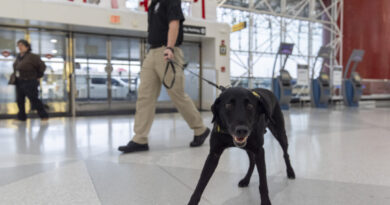Health Risks Loom as California Fire Evacuees Return Home
Risks involve contaminated water, hazardous debris, and the possibility of landslides, while strong winds are making a return.
On January 20, officials permitted more residents of Southern California to return to their homes in areas impacted by the devastating wildfires, but many are confronted with dangers such as contaminated water, hazardous debris, and the risk of landslides.
The major wildfires, Palisades and Eaton, which ignited on January 7, continue to burn. This week, fire crews have gained the advantage on both fronts despite the resurgence of Santa Ana winds and red-flag fire danger weather alerts, as indicated by the California Department of Forestry and Fire Management (Cal Fire).
On Sunday, the county’s public health department released a dust and ash advisory in anticipation of another wave of strong Santa Ana winds predicted to impact the area beginning Tuesday.
Health authorities recommended that the public stay indoors, keep windows and doors shut, wear masks, and protect their eyes.
Any cleanup or debris removal must receive approval and comply with local, state, and federal regulations as outlined in the health order.
“Examples of fire debris include charred building materials (wood, metal, concrete), damaged household items, fragments of building foundations, and soil contaminated by the fire around burned structures or affected regions, which may harbor harmful substances,” the order stated.
The public is also warned that fire-affected lithium-ion batteries—commonly found in electronic devices, electric vehicles, and energy storage systems—pose a “significant risk and should not be handled,” as per the health order.
The Pacific Palisades Fire has claimed 10 lives and destroyed 6,051 homes, having spread over 23,700 acres, or 37 square miles, as of Monday and is currently 59 percent contained, according to Cal Fire.
Officials are re-evaluating evacuation protocols to facilitate residents’ return on Monday.

The fireplace and chimney of a home destroyed in the Eaton Fire in Altadena, Calif., on Jan. 16. Brandon Bell/Getty Images
“A soft closure means the area is inaccessible to the general public,” the sheriff’s office stated on Monday. “It is still accessible to disaster response teams, public safety personnel, and residents with proper identification.”
Members of the California National Guard continue to man checkpoints and will request identification, according to the sheriff’s department.

California Gov. Gavin Newsom and Los Angeles Mayor Karen Bass tour the downtown business district of Pacific Palisades as the fire continues to burn on Jan. 8. Eric Thayer/Getty Images
At this time, motor homes, trailers, and moving trucks are still prohibited from entering the fire zone, and residents are urged not to remove anything from their properties, including debris.
Fire crews are making progress in suppressing the Eaton Fire, which has resulted in 17 fatalities and the destruction of 9,416 homes and buildings in Altadena and Pasadena, now achieving 87 percent containment.
The Eaton Fire has scorched approximately 14,021 acres, or 21 square miles, as of Monday morning, around 15 miles east of Los Angeles.
Air operations continued to assist ground firefighters by extinguishing hotspots on Monday in the challenging, inaccessible terrain near Winters Creek, Mount Lowe, and Mount Wilson, according to Cal Fire.
“As firefighting efforts continue across Los Angeles County, the state is proactively preparing for the potential damage that winter rainstorms can inflict on burn scars, leading to landslides and flooding,” Newsom communicated in a statement on Sunday. “This order ensures that our emergency response remains focused on the protection of communities, rather than on permits and paperwork.”

Destruction caused by the Palisades Fire north of Los Angeles on Jan. 9. John Fredricks/The Epoch Times
In the Eaton Fire area, customers of the Kinneloa Irrigation District, Las Flores Water Company, Lincoln Water Company, Pasadena Water and Power, and the Rubio Canon Land and Water Association were issued “do not drink” advisories.
The California Water Resources Control Board’s Division of Drinking Water has cautioned all clients in those districts against consuming the water.
“Due to the Eaton Fire, water quality may be compromised and is unsafe for public consumption and use until further notice,” the state declared in an alert.
In the Palisades Fire region, residents in the 90270 area code supplied by the Los Angeles Department of Water and Power and the Los Angeles County Waterworks Districts No. 29 in Malibu have also been issued “do not drink” alerts by the state.





